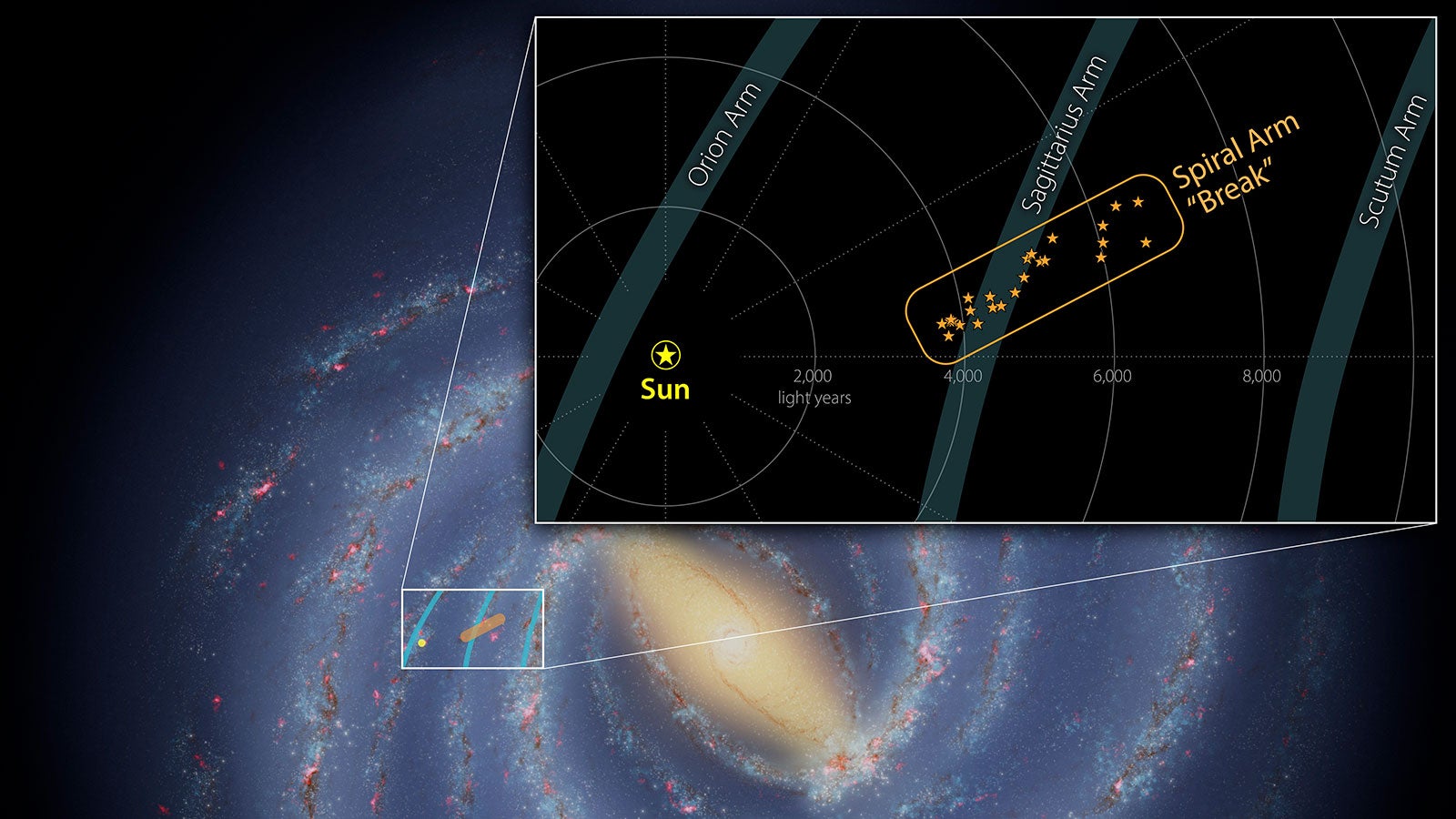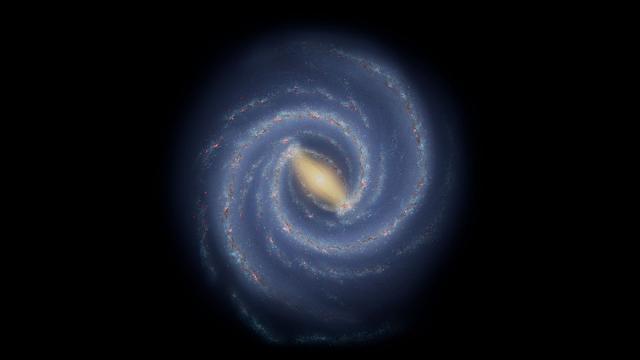An unusual “break” has been detected in the nearest galactic spiral arm to Earth. Astronomers have never seen anything quite like it, and they’re not entirely sure how it got there.
New research published in Astronomy & Astrophysics describes a “high pitch angle structure in the Sagittarius Arm.” By “high pitch,” the astronomers are referring to the extreme angle at which this elongated cluster of stars sticks out from the Sagittarius Arm of the Milky Way. The newly detected feature measures 3,000 light-years in length (that’s less than 3% of the total diameter of the entire galaxy), and it consists of young stars and star-forming gas clouds. Astrophysicist Michael Kuhn from Caltech is the study’s lead author.

Mapping the various features within our galaxy ain’t easy, and that’s because we’re living directly inside the thing. As the new paper says, “it has been challenging to connect individual star-forming regions to their larger Galactic environment owing to our perspective from within the disk.”
Thankfully, astronomical tools and techniques can help in this regard. In this case, Kuhn and his colleagues analysed data gathered by the Spitzer Space Telescope, which NASA retired just last year. Spitzer detected infrared light, making it an ideal tool for observing newly birthed stars that would otherwise be blanketed by the thick clouds of gas and dust (i.e. nebulae) from which they formed. Specifically, the team looked at data from a survey called Galactic Legacy Infrared Mid-Plane Survey Extraordinaire (GLIMPSE), in which Spitzer scanned more than 100,000 baby stars.
Data from the European Space Agency’s Gaia mission was also analysed, providing the team with precise measurements of distances between stars. This allowed them to create a 3D view of the Sagittarius Arm — a prominent spiral arm of the Milky Way galaxy.
“When we put the Gaia and Spitzer data together and finally see this detailed, three-dimensional map, we can see that there’s quite a bit of complexity in this region that just hasn’t been apparent before,” Kuhn said in a NASA press release.
The Sagittarius Arm is a well-studied feature of the Milky Way, and it hosts several gigantic star-forming regions, including the Omega Nebula, the Trifid Nebula, the Lagoon Nebula, and the Eagle Nebula, the latter of which contains the famous Pillars of Creation. For the new study, the researchers sought to map the locations and speeds of star-forming regions in a segment of the Sagittarius Arm.
The newly detected structure sticks out at a pitch angle of nearly 60 degrees. The Arm itself wraps tightly around the Milky Way at a pitch angle of 12 degrees (for context, a perfect circle has a pitch angle of 0 degrees). Hence the description of the splinter as a high pitch angle structure.
“Ultimately, this is a reminder that there are many uncertainties about the large-scale structure of the Milky Way, and we need to look at the details if we want to understand that bigger picture,” explained Robert Benjamin, an astrophysicist at the University of Wisconsin-Whitewater and a principal investigator for GLIMPSE.
The authors of the new paper aren’t entirely sure how the splinter formed, but the baby stars within this expanse likely came into existence at the same time and place. As closely related siblings, these stars should’ve been affected by the same influences churned by the galaxy’s rotation — forces like gravity and shear. Thus, improved models of stars, both in terms of their distances to each other and their velocities, could shed light on this new astronomical mystery and galactic spirals in general, which are likewise mysterious.
“This structure is a small piece of the Milky Way, but it could tell us something significant about the Galaxy as a whole,” said Benjamin.
Astronomers have observed odd-ball features in other spiral galaxies before, including things called spurs and feathers, some of which stick out perpendicularly from spiral arms. Spurs are bright spots caused by an abundance of stars, while feathers are conglomerations of dust. The new feature seen in the Milky Way is neither of these and is thus considered unique.
It’s now an open question as to whether other high pitch angle structures exist in our galaxy or elsewhere in the universe. This will be the focus of future work, along with further research to confirm the new feature as a bona fide substructure with the Sagittarius Arm.
